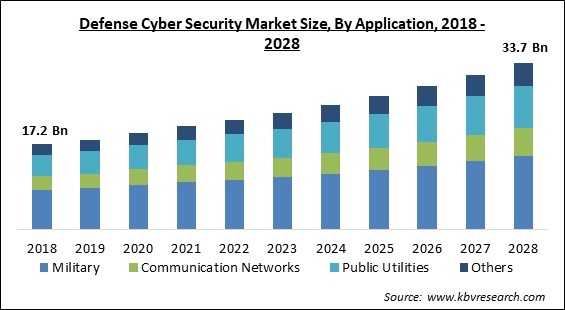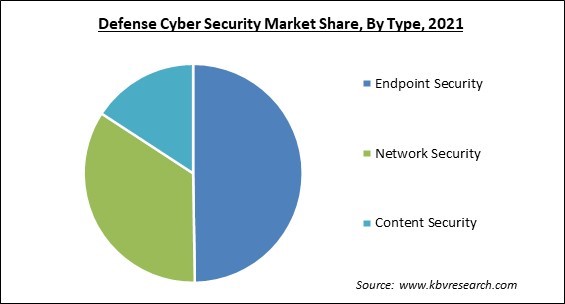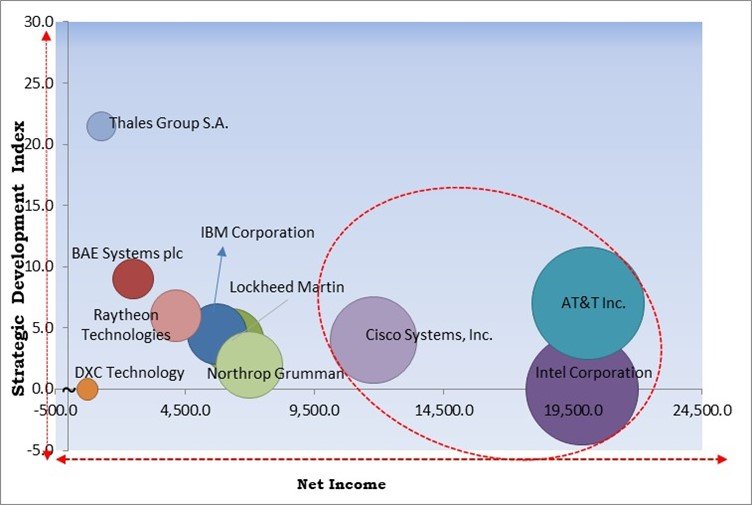The Global Defense Cyber Security Market size is expected to reach $33.7 billion by 2028, rising at a market growth of 7.3% CAGR during the forecast period.
Cybersecurity protects assets from terrorism, cybercrime, and other network service disruptions. Cybersecurity solutions aid defense organizations in detecting, supervising, reporting, and tackling the cyber threats that internet-based attempts to disrupt or damage the information systems and hack essential information utilizing malware, spyware, and phishing to steal data from these organizations.

Presently, cyber threats are more persistent, smarter, and concentrated on high-value assets, which have increased the demand for a strong and high-tech cyber security system for defense industry. Furthermore, the growing risk of the cyber threat to critical infrastructures by criminal organizations and the technological enhancement in the cyber security industry is the major driving factor in its increased utilization throughout defense organizations.
A more connected defense & intelligence world would ensure that the soldiers get information with precision and in less time. But increased connectivity also means more ways for cyberattacks, data leaks, and other breaches in IT (information & technology) security. This remains the issue at the crux of modern cybersecurity problems. However, technological developments would give organizations more techniques and tools to protect themselves from any significant cyberattack on their networks. Various cybersecurity companies are introducing new and enhanced products which can aid cybersecurity professionals in defending legacy and cloud networks, which can help the defense forces to work soundly while keeping their networks safe.
Organizations are speeding up their digital transformation and cyber security as much of the work starts to get online. With this, the operational, legal, reputational, and compliance implications would be significant if the cybersecurity risk is neglected. Out of these organizations, defense is among the topmost sector to adopt cyber security solutions to safeguard their confidential data from cyberattacks. Many governments have increased funding for adopting cyber security in the military, which aids the government & military in blocking any upcoming threats and sharing intelligence about the cyber activity. The defense’s increasing adoption of cyber security to secure their database and information has propelled the market growth during the pandemic.
Defense IT expenses are on the surge across many developed nations. The growth of IT software, hardware, and services has implemented several changes in the defense sector, including live combat surveillance, superiority in air & space, smart weapons and battlefield management in network-centric environments, and force multipliers-related software. In addition, implementing IT solutions has become significant in defense operations due to the increasing evolution in the type and occurrence of attacks globally.
The rising number of artificial intelligence applications in aircraft may require reliable and high-tech defence cyber security solutions. New technological advancements like the maintenance capability are used to defend the aircraft's onboard systems from cyber-attacks. These new systems aid in increasing the aircraft defence against cyber threats and give the flight-critical abilities to verify and install multiple software and mission data files onto the aircraft. This development of autonomous aircraft to protect them from cyberattack and ensures their proper operation while being efficient by the military is expected to boost the defence cybersecurity market's growth.
Against any intrusion by offenders, criminals, or antagonistic countries, the government workforce is the first line of defence. The internet has made it easier for the antagonist to attack any department, municipality, agency, or department of any nation. Nations with IT technology are easily targeted for malware infections or ransomware attacks. That is why attacker targets under-prepared government bureaucrats with malware, email phishing scams, or stolen passwords to enter and steal confidential government data or lock up critical systems needed for the services and operations. For instance, phishing scams utilize fake emails or text messages to lure individuals into clicking on sketchy website links to steal personal information.
By deployment, the defense cyber security market is classified into on-premises and cloud. The cloud segment projected a prominent growth rate in the defense cybersecurity market in 2021. This is because cloud-based technology operates on remote system servers over the internet, which don’t require any dedicated server specialist for maintenance. The cloud-managed services are generally available as SaaS (security as a service) models with annual or monthly charges. These charges cover the monitoring, supervision of network servers, cloud storage for all data, backup recovery, system optimization, etc.
On the basis of type, the defense cyber security market is divided into endpoint security, network security and content security. The endpoint security segment held the highest revenue share in the defense cyber security market in 2021. The growth is due to the increasing usage of behavioral and automation analysis for threat detection. These solutions are considered to be an essential asset of the defense sector. Also, many key players have started to invest heavily in these solutions. Hence, the rising investments, with the growing amount of data across different verticals within the defense sector have surged the segment’s market expansion in the forecasted period.
Based on offering, the defense cyber security market is bifurcated into solutions and services. The services segment held the highest revenue share in the defense cyber security market in 2021. This is due to their assistance in identifying vulnerabilities, ensuring security, and closing protection gaps, which work efficiently to prevent any cyber breach. With cyber security, organizations attain a synergistic balance from all three facets of defense in depth strategy, which are operation, people, and technology. This would support the market expansion in this segment.
Based on application, the defense cyber security market is segmented into military, public utilities, communication networks and others. The military segment dominated the defense cyber security market with the maximum revenue share in 2021. This is because various defense groups can only operate efficiently if the information is shared securely. Using cyber security systems, the military can send messages, media, reports, and broadcasts while also being able to make secure calls. As a result, security officers may access needed information securely.

| Report Attribute | Details |
|---|---|
| Market size value in 2021 | USD 20.9 Billion |
| Market size forecast in 2028 | USD 33.7 Billion |
| Base Year | 2021 |
| Historical Period | 2018 to 2020 |
| Forecast Period | 2022 to 2028 |
| Revenue Growth Rate | CAGR of 7.3% from 2022 to 2028 |
| Number of Pages | 355 |
| Number of Tables | 574 |
| Report coverage | Market Trends, Revenue Estimation and Forecast, Segmentation Analysis, Regional and Country Breakdown, Competitive Landscape, Companies Strategic Developments, Company Profiling |
| Segments covered | Deployment, Type, Offering, Application, Region |
| Country scope | US, Canada, Mexico, Germany, UK, France, Russia, Spain, Italy, China, Japan, India, South Korea, Singapore, Malaysia, Brazil, Argentina, UAE, Saudi Arabia, South Africa, Nigeria |
| Growth Drivers |
|
| Restraints |
|
Region-wise, the defense cybersecurity market is analyzed across North America, Europe, Asia Pacific, and LAMEA. The North America region held the highest revenue share in the defense cyber security market in 2021. This is due to the robust presence of various market incumbents, combined with the region's recent threats. The defense sector in many nations across the region are increasing their spending, which has surged the requirement for defense cyber security. As many developed countries depend on the internet for their daily work and various other operations, cybersecurity applications have increased and thereby boosted the market growth in the region.
Free Valuable Insights: Global Defense Cyber Security Market size to reach USD 33.7 Billion by 2028

The major strategies followed by the market participants are Partnerships. Based on the Analysis presented in the Cardinal matrix; AT&T, Inc., Intel Corporation and Cisco Systems, Inc. are the forerunners in the Defense Cyber Security Market. Companies such as Thales Group S.A., BAE Systems PLC, and IBM Corporation are some of the key innovators in Defense Cyber Security Market.
The market research report covers the analysis of key stake holders of the market. Key companies profiled in the report include Intel Corporation, AT&T Inc., IBM Corporation, BAE Systems plc, Thales Group S.A., DXC Technology Company, Cisco Systems, Inc., Raytheon Technologies, Corporation (Collins Aerospace), Lockheed Martin Corporation, Northrop Grumman Corporation.
By Deployment
By Type
By Offering
By Application
By Geography
The global Defense Cyber Security Market size is expected to reach $33.7 billion by 2028.
Rising IT expenditure for defense are driving the market in coming years, however, Less awareness regarding cybersecurity restraints the growth of the market.
Intel Corporation, AT&T Inc., IBM Corporation, BAE Systems plc, Thales Group S.A., DXC Technology Company, Cisco Systems, Inc., Raytheon Technologies, Corporation (Collins Aerospace), Lockheed Martin Corporation, Northrop Grumman Corporation.
The On-premise market acquired the maximum revenue share in the Global Defense Cyber Security Market by Deployment in 2021, achieving a market value of $17.7 billion by 2028.
The Solution market is leading the Global Defense Cyber Security Market by Offering in 2021, thereby, achieving a market value of $25.4 Billion by 2028
The North America market dominated the Global Defense Cyber Security Market by Region in 2021, and would continue to be a dominant market till 2028; thereby, achieving a market value of $11.9 billion by 2028.
Our team of dedicated experts can provide you with attractive expansion opportunities for your business.

